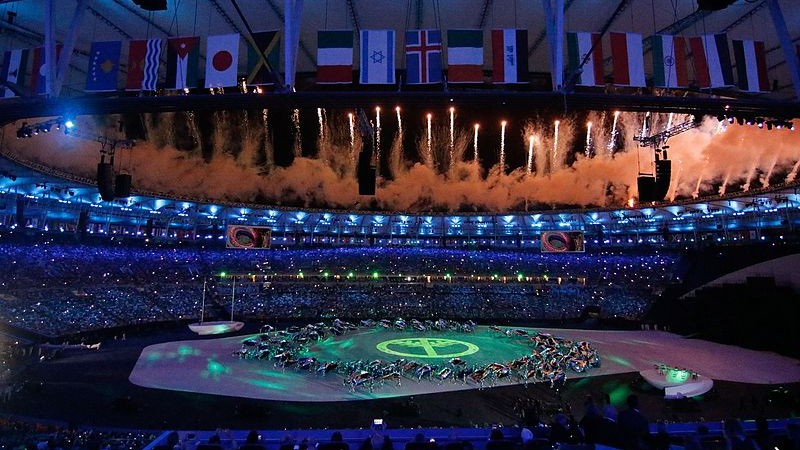Hectoring and kitsch or brave and groundbreaking? The environmental theme of Rio’s Olympic opening ceremony has divided the internet.
The night bequeathed two standout images to the green narrative. First, an infomercial on climate change, complete with data, diagrams, and maps of seawater bleeding across Amsterdam, Florida and Dubai.
Second, a flower pushing up through the stadium floor: “A flower has sprouted in the street […] it has fooled the police, it’s breaking through the asphalt,” read the mother-earth voice of Dame Judy Dench.
The diagrams were clear but staid, the plant symbols poetic but safe. And neither back-story was developed much by either rings of trees bursting out of silver plinths, nor the promise of a new national park.
Now while there’s evidence to suggest that reminders of things we love are more motivational than threats of those we fear (and who doesn’t want to protect a good tree or rainforest), there’s also a risk that over-simplistic, clichéd symbolism does as much to harm engagement as it helps.
That doesn’t mean the symbols we use need to be complex. They could simply start with being honest. Here for example, are five deeper and more daring images that could have been used instead.
1. Indigenous activists to light the flame
To be fair to artistic director Fernando Meirelles, this is one that he apparently suggested himself. But which seems to have been considered a no-go by the powers that be.
Perhaps because it comes too close to highlighting the country’s appalling reputation in this area: last year Global Witness documented 50 lethal attacks against environmental activists in Brazil – the worst record in the world.
Many of those killed were indigenous people attempting to defend the Amazon from logging, damming or cattle and similar groups have historically played a large part in helping reverse the country’s deforestation rates.
Yet the sad truth is that, after years of impressive improvement, tree loss is once again on the rise.

Indigenous activist Tashka Yawanawa giving a TED Talk (Photo: James Duncan Davidson/TED)
2. A geometric collage of wind turbines
Brazil is rightly proud of having slashed its rate of emissions (compared to levels in 2005) and of its status as the first as the first major developing economy to have set an economy-wide emissions target.
Yet Brazil’s economy is reliant not just on oil, but on two of the world’s most environmentally destructive energy sources: hydro-dams and bio-fuel production.
And while the cancellation of a new mega-dam just hours before the ceremony began was a welcome move in the right direction, the display’s failure to even hint at how future emissions targets are to be met was a damned shame.

A windfarm in Brazil (Flickr/The Danish Wind Industry Association)
3. A nod to Norway
The story of Brazil’s deforestation is far from new. Until recently, Norway was one of the few countries to respond by opening its chequebook.
In 2008, it pledged US$1 billion to the Amazon Fund – a commitment that helped stave off the development of the rainforest by agribusiness and which is now paid in full.
Rich countries have promised to mobilise $100 billion a year by 2020 to help poorer parts of the world go green and adapt to a changing climate.
Still, it is a contentious topic, with disputes over what counts as climate finance and obstacles to that cash flow.
4. The flower could have at least been edible
If Brazil is to continue to as one of the world’s greatest food producers it has got to make that production sustainable. That means producing more food on less land (and certainly less land claimed from the rainforest).
This report has some good ideas about how that might be achieved but they will need to be backed up by policy.
5. A sprinkler display using water from restored watersheds
Thanks to a combination of deforestation and record-breaking global temperatures parts of Brazil are in the grip of severe drought.
Yet local efforts are beginning to reverse this trend – with communities in the Guandu region of Rio helping restore thousands of degraded acres of watershed.
And with temperatures in Rio forecast to run in the middle 80s, I’m sure the athletes would have welcomed a cool down.

Sao Paolo’s Guarapiranga reservoir in 2014 (Flickr/ Scrolleditorial)
This said, Brazil is only to be congratulated for putting the environment at the heart of the 2016 Games; not because nature matters more than people but because so much quality of life depends on how we use its resources.
And there is certainly much to be admired in Rio’s moving, timely and “cool” production – not least in the shoestring ceremony’s reminder that good intentions don’t have to cost the earth.
For the West to pour scorn when a developing country reminds us of this thus seems distasteful at best, irresponsible at worst. Yet we also need to start moving the environmental narrative on.
The economic dilemmas, the political divides, and the miraculous (and increasingly cheap) nature of their solutions shouldn’t be shied away from; they should be made inspirational too – or they risk alienating those who think the story begins and ends with dancing trees.
Perhaps to get cool on a planetary scale, Rio has shown we have to get even more creative.
India Bourke is editorial assistant at the New Statesman and writes about energy and the environment
